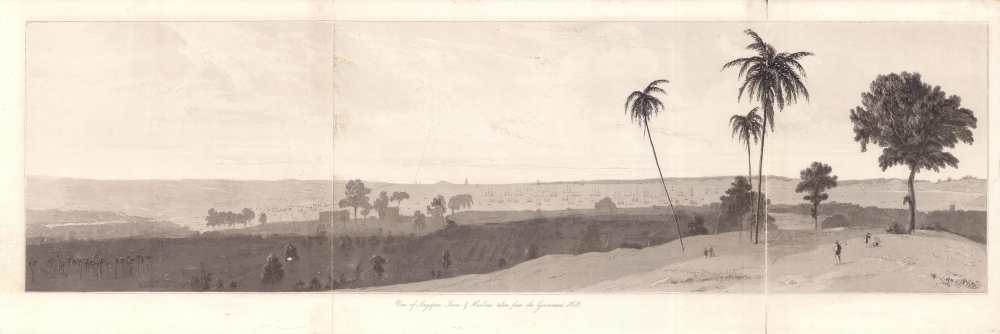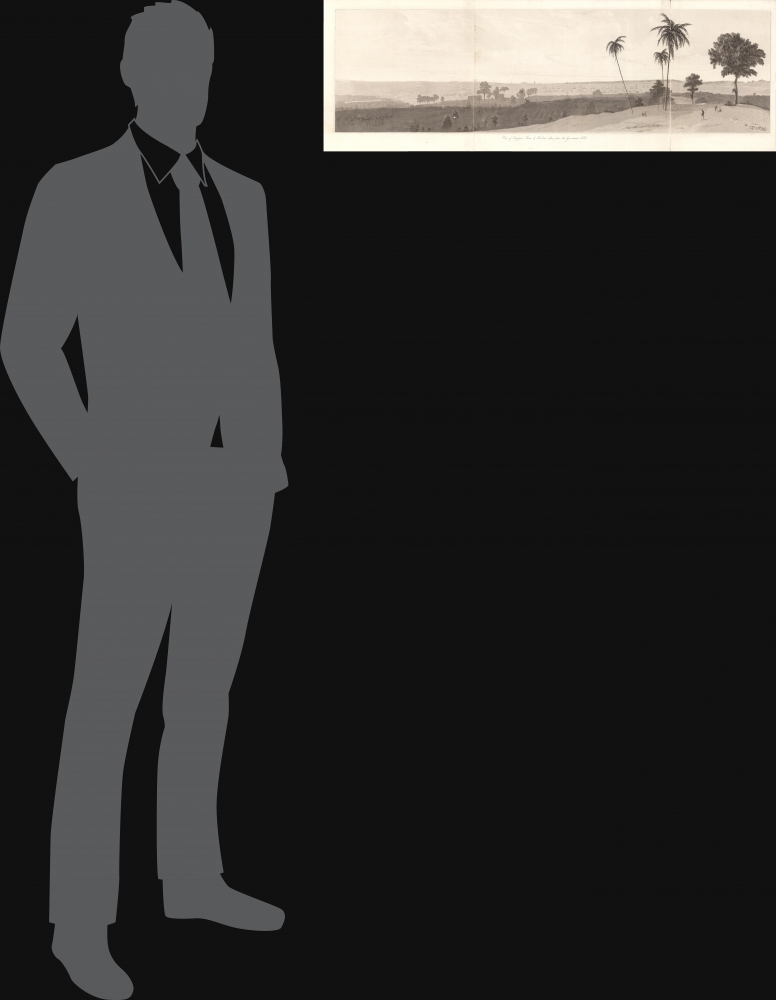1830 Daniell View of Singapore
SingaporeView-daniellwilliam-1830
Title
1830 (undated) 10 x 32 in (25.4 x 81.28 cm)
Description
A Closer Look
Oriented towards the southeast, this view looks over the town of Singapore and out into Singapore Harbor from Government Hill (now Fort Canning Hill, formerly Bukit Larangan). Founded hardly a decade before, Singapore is depicted as a fast-growing colonial outpost, with the harbor full of ships of various sizes and types, as is the inlet at right, likely the Telok Ayer Bay or perhaps the Singapore River. On land, several multistory colonial and indigenous-style buildings appear.Raffles' Vision for Singapore
The distinct architectural styles in different parts of the city reflect the social and racial segregation imposed by the 'Raffles Plan,' as do the neatly organized city streets at left. Raffles intended the city's various communities (European, Chinese, Malay, Arab, Indian) to live in closely situated but distinct neighborhoods, with other areas designated for trade and public use. These moves presaged the city's long history of strained yet functional multiculturalism, assisted by the riches of unrestrained commerce.Publication History and Census
Though his name does not appear here, this view is generally attributed to William Daniell. It appeared in Memoir of the Life and Public Services of Sir Thomas Stamford Raffles, published by John Murray in 1830, and is one of the earliest published views of the city following the 1828 Elliot/Crawfurd view (previously sold by us). The view is not independently cataloged with any institution and is scarce to the market, while the entire Memoir is held by a handful of institutions worldwide.CartographerS
William Daniell (1769 - 1837) was a painter, engraver, and printmaker who was known especially for his works employing aquatint. Born in Surrey, Daniell went to live with his uncle, landscape painter Thomas Daniell, after his father's death in 1779. His brother Samiel Daniell also became a painter who was known for his views of Africa, drawn from first-hand observations. Similarly, in 1784 William accompanied his uncle to India, where they would spend the next decade travelling throughout the subcontinent and sketching and painting views that were then printed as aquatints, many of which ended up in their celebrated work Oriental Scenery. In 1794, William and his uncle returned to England and adopted a wide range of subjects for their works. Between 1813 and 1823, William dedicated himself to the ambitious work A Voyage Round Great Britain, a series of prints based on his travels around the entire coastline of England, Wales, and Scotland. Widely celebrated in the latter part of his life, William became a Royal Academician in 1822. More by this mapmaker...
John Murray I (1737 - 1793) founded the British publishing firm John Murray (1768 - present) in London. Born in Edinburgh, Murray served as an officer in the Royal Marines and built a list of authors that included Isaac D’Israeli and published the English Review. Murray the elder also was one of the founding sponsors of the London evening newspaper The Star in 1788. John Murray II (November 27 1778 - June 27, 1843) continued the family publishing business and developed it into one of the most important and influential publishing houses in Britain. The list of authors published by the firm grew to include Jane Austen, Sir Walter Scott, Washington Irving, George Crabbe, and Lord Byron under his tenure. Murray II also moved the business to 50 Albermarle Street in Mayfair, which became famous for Murray’s tradition of ‘four o’clock friends’, which was afternoon tea with his writers. John Murray III (1808 - 1892) continued to grow the business, and the firm published the first English translation of Goethe’s Theory of Colours, David Livingstone’s Missionary Travels and Charles Darwin’s Origin of Species during his tenure. Murray also published Herman Melville’s first two books. The firm began publishing Murray Handbooks in 1836, an ancestor of all modern travel guides. Sir John Murray IV (1851 - 1928) was publisher to Queen Victoria. Three successive Murray’s after Murray IV led the business until it was purchased by Hodder Headline in 2002, which was acquired by the French conglomerate Lagardère Group in 2004. Today, Murray is an imprint of Lagardère under the imprint Hachette UK. Learn More...




